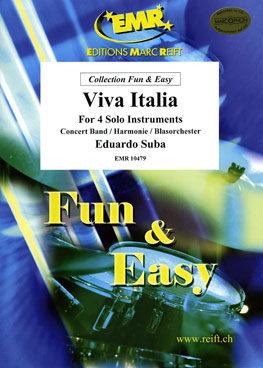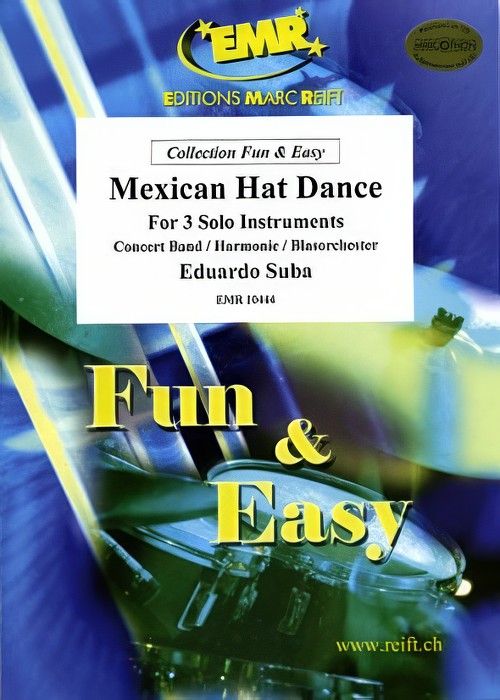Results
-
 £84.99
£84.99Flutes Forever - Wim Laseroms
As the title implies this new piece brings the flute section into the limelight. Following a fast introduction by the accompanying band, the flute section follows in three-parts with a rapidly syncopated/staccato theme. After a short interlude by the band, this opening theme appears once again. The second flute theme returns following a short passage in which the band and the soloists alternate and the piece comes to a entertaining conclusion. Let your flute section shine with this playful new work.
Estimated dispatch 7-14 working days
-
 £21.50
£21.50Washington's Fanfare - Alexander N. Abbott
Abbott's new flute choir rings true to the best of the presidential fanfares, an original work which evokes the pageantry and honor of its subject. Score and parts are supplied for piccolo, 3 flutes, alto flute, bass flute, contrabass flute, and string bass, with many substitution options.
Estimated dispatch 7-14 working days
-
 £32.95
£32.95Sinfonia From Cantata No.29 - Johann Sebastian Bach
Traditionally performed by solo organ, Bach's Sinfonia from Cantata No. 29 is arranged here for flute choir, with the piccolo parts closely following how an organist would perform the music. This arrangement has interesting textural and dynamic contrast, despite few dynamic markings, which Long creates through thoughtful scoring of different flute parts playing in various registers of the flute range. This arrangement was premiered in July of 2009 by the New England Conservatory Summer Metropolitan Flute Festival Orchestra in the New England Conservatory's renowned Jordan Hall. For advanced players.
Estimated dispatch 7-14 working days
-
£84.99
Flutes Forever (Concert Band - Score and Parts)
As the title implies this new piece brings the flute section into the limelight. Following a fast introduction by the accompanying band, the flute section follows in three-parts with a rapidly syncopated/staccato theme. After a short interlude by the band, this opening theme appears once again. The second flute theme returns following a short passage in which the band and the soloists alternate and the piece comes to a entertaining conclusion. Let your flute section shine with this playful new work. 03:00
Estimated dispatch 7-14 working days
-
 £97.00
£97.00VIVA ITALIA (Flexible Quartet with Easy Concert Band) - Suba, Eduardo
Quartet instrumentation: Part 1 - Flute, Clarinet, Alto Sax or Trumpet; Part 2 - Flute, Clarinet, Alto Sax or Trumpet; Part 3 - Flute, Clarinet, Alto Sax or Trumpet; Part 4 - Flute, Clarinet, Alto Sax, Tenor Sax or Trumpet. Duration: 4:20
Estimated dispatch 7-14 working days
-
 £113.30
£113.30Moderate Dances - Angelo Sormani
This piece is a tribute to dance music, especially passionate, intense and meditative dance music. "Moderate Dances" is divided into three movements: a "Tango", a "Slow Waltz" and a "Bossa Nova". Each movement and each dance has its own particular characteristics but, when combined, these different rhythmic beats and times give the piece a feeling of completeness and uniformity. The Tango started to flourish in the suburbs of Buenos Aires in around 1880. There is still some doubt as to its origins, which may be Cuban (Habanera) but are probably African. It was most popular in Argentina and Brazil: here the male protagonist was originally the "gaucho" with his inseparable guitar, later to be replaced by the proud, elegant "compadre". By around 1910 the Tango had spread to Italy and France. New clubs opened, where the upper classes could watch and dance the Tango. Here the dance also underwent some rapid transformations. The exaggerated and extravagant gestures and body movements disappeared. Slow, gliding steps replaced the old rotational movements. The women's red ankle-boots and the partners "staring into each other's eyes" accentuated the erotic nature and sensuality of this dance. So much so that, in 1913, the German government banned soldiers from dancing the Tango. Those who broke the law were immediately discharged from the army. From a strictly musical perspective, the basic instruments were a flute, a harp (the diatonic harp typically played by the Indians of Paraguay) and a violin, or flute, guitar and violin or even clarinet, guitar and violin. These instruments were easy to transport, ideal for playing at parties, in the streets and in courtyards. The musicians played by ear, frequently improvising: there were no scores, no records, which is the main reason why it is impossible to trace the Tango back to its exact origins. However, the Tango's evolution (and growing popularity) was once again fostered by its fundamental ability to absorb "other" cultures, languages and sounds. And it was the arrival of the "bandoneon" (an accordion-like instrument that was invented in Germany and brought to Rio de la Plata by some immigrant), which replaced the flute, that marked the beginning of the Tango's huge success outside Argentina. A number of talented composers, above all the great Astor Piazzola (1921-1992), transformed the bandoneon from a simple accompanying instrument to a solo instrument that was to become the distinguishing feature of the 20th century Tango. The Slow Waltz originated from the Waltz, the typical dance of the Bavarian and Tyrolese peasants in the 1700s. It was composers like Johann Strauss, father and son, who carried the Waltz to its zenith in the 1800s, creating the sensual and melancholy yet joyful and charming dance we are all familiar with. When the Waltz first became popular in Germany, the members of respectable society were shocked at the closeness of the dancing partners, who had always previously danced apart. The main difference between the Waltz and Slow Waltz is that the latter has a slower, more expressive rhythm: the men wear tails and the women wear ball gowns decorated with beads and feathers and couples dance in graceful rotational movements. "Bossa Nova" is the title of the last movement in the piece. Jobim, the great Brazilian musician, described this musical genre as a combination of modern Jazz and Samba. Bossa Nova means "new wave". This was the name of the artistic and musical movement that evolved in Brazil in the late Fifties and was extremely popular throughout the Sixties. The songs are usually about love or social matters, drawing inspiration from the slums of Rio De Janeiro and the lives of their inhabitants. Bossa Nova, with its original compositions and the artistic talent of its musicians, also became hugely popular in the United States and Europe, and top Jazz musicians (Ella Fitzgerald, Stan Getz, Bob Cooper, Charlie Bird, Sonny Rollins, Dexter Gordon, Dizzy Gillespie) started to include Bossa in their repertoires.
Estimated dispatch 7-14 working days
-
 £84.99
£84.99Twinkling Flutes - Richard Comello
Composer Richard Comello observed that there is practically no music written for two flutes accompanied by concert band, so he composed this delightful piece convinced that this it will fill this little gap in the repertoire. Following a solemn baroque style introduction, joyful characteristic flute sounds develop with subtle band accompaniment. The two flute parts can be played by more players so enabling this piece to put your complete flute section in the spotlight.
Estimated dispatch 7-14 working days
-
 £87.70
£87.70Introduction and Rondo Capriccioso - Camille Saint-Saëns
A brilliant transcription of this very famous violin solo, utilizing a more chamber-like wind ensemble scoring in order to maintain the delicate balance between the soloist and ensemble. Instrumentation: Solo Flute, C Flute 1, C Flute 2, Oboe 1, Oboe 2, Clarinet 1, Clarinet 2, Bass Clarinet, Bassoon, Horn 1, Horn 2, Trumpet 1, Trumpet 2, Euphonium (T.C. and B.C.), Tuba, Timpani
Estimated dispatch 7-14 working days
-
 £96.40
£96.40The Elephant and the Fly - Henri Kling
This newly revised edition of perennial favorite "The Elephant and the Fly" is based on the original parts published in 1918. This updated version includes a full score, in addition to a few adaptations/transpositions to accommodate modern band instruments. Lastly, each of the solo parts is transposed into a variety of keys, such that a variety of soloist combinations are now possible. Instrumentation: Solo Piccolo (or Flute/Clarinet/Trumpet), Solo Trombone (or Bassoon/Bass Clarinet/Tuba), Flute 1, Flute 2, Oboe 1/2, E-Flat Clarinet, Clarinet 1, Clarinet 2/3, Bass Clarinet, Soprano Saxophone (or alternate Alto Saxophone), Alto Saxophone, Tenor Saxophone, BaritoneSaxophone, Bassoon, Horn 1/3, Horn 2/4, Solo Cornet, Cornet 1, Cornet 2/3, Trombone 1/2, Bass Trombone, Euphonium, Tuba, Percussion
Estimated dispatch 7-14 working days
-
 £125.00
£125.00Mexican Hat Dance (Flexible Trio with Concert Band - Score and Parts) - Suba, Eduardo
1st Solo part available for: Flute, Clarinet, Alto Sax, Trumpet2nd Solo part available for: Flute, Clarinet, Alto Sax, Trumpet3rd Solo part available for: Flute, Clarinet, Alto Sax, Tenor Sax, TrumpetDuration: 2:00
Estimated dispatch 7-14 working days
